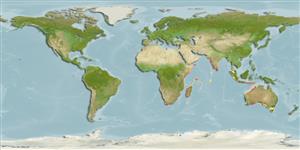>
Carangiformes (Jacks) >
Carangidae (Jacks and pompanos) > Trachinotinae
Etymology: Trachinotus: Greek, trachys, -eia, -ys = rough + Greek,noton = back (Ref. 45335).
More on author: Smith.
Environment: milieu / climate zone / depth range / distribution range
Ecologia
marino; salmastro associati a barriera corallina; distribuzione batimetrica 20 - 50 m (Ref. 28016). Tropical
Indian Ocean: Gulf of Aden and Oman, Mozambique and South Africa to western Indonesia.
Size / Peso / Age
Maturity: Lm ? range ? - ? cm
Max length : 92.0 cm TL maschio/sesso non determinato; (Ref. 3287); peso massimo pubblicato: 14.1 kg (Ref. 3287)
Spine dorsali (totale) : 7; Raggi dorsali molli (totale) : 21 - 23; Spine anali: 3; Raggi anali molli: 19 - 21.
Adults inhabit coastal areas with reefs or rocky outcrops (Ref. 3197). They are found normally in pairs on reefs but may be solitary or form schools (Ref. 5213, 90102). Juveniles in sheltered bays. Adults feed on mollusks (mussels) and crabs (Ref. 5213).
Life cycle and mating behavior
Maturità | Riproduzione | Deposizione | Uova | Fecundity | Larve
Smith-Vaniz, W.F., 1984. Carangidae. In W. Fischer and G. Bianchi (eds.) FAO species identification sheets for fishery purposes. Western Indian Ocean fishing area 51. Vol. 1. [pag. var.]. FAO, Rome. (Ref. 3287)
IUCN Red List Status (Ref. 130435: Version 2024-1)
Threat to humans
Harmless
Human uses
Pesca: scarso interesse commerciale; Pesce da pesca sportiva: si; Acquario: Acquari pubblici
Strumenti
Special reports
Download XML
Fonti Internet
Estimates based on models
Preferred temperature (Ref.
123201): 18.3 - 28.2, mean 26.2 °C (based on 49 cells).
Phylogenetic diversity index (Ref.
82804): PD
50 = 0.5000 [Uniqueness, from 0.5 = low to 2.0 = high].
Bayesian length-weight: a=0.01995 (0.00854 - 0.04661), b=2.87 (2.69 - 3.05), in cm total length, based on LWR estimates for this Genus-body shape (Ref.
93245).
Trophic level (Ref.
69278): 3.4 ±0.35 se; based on food items.
Resilienza (Ref.
120179): Medio, tempo minimo di raddoppiamento della popolazione 1.4 - 4.4 anni (Preliminary K or Fecundity.).
Fishing Vulnerability (Ref.
59153): High vulnerability (57 of 100).
Nutrients (Ref.
124155): Calcium = 36.3 [16.0, 66.7] mg/100g; Iron = 0.608 [0.341, 1.244] mg/100g; Protein = 19.4 [17.4, 21.4] %; Omega3 = 0.103 [0.063, 0.184] g/100g; Selenium = 40.6 [21.7, 82.3] μg/100g; VitaminA = 25.4 [6.5, 92.8] μg/100g; Zinc = 0.965 [0.641, 1.400] mg/100g (wet weight);
